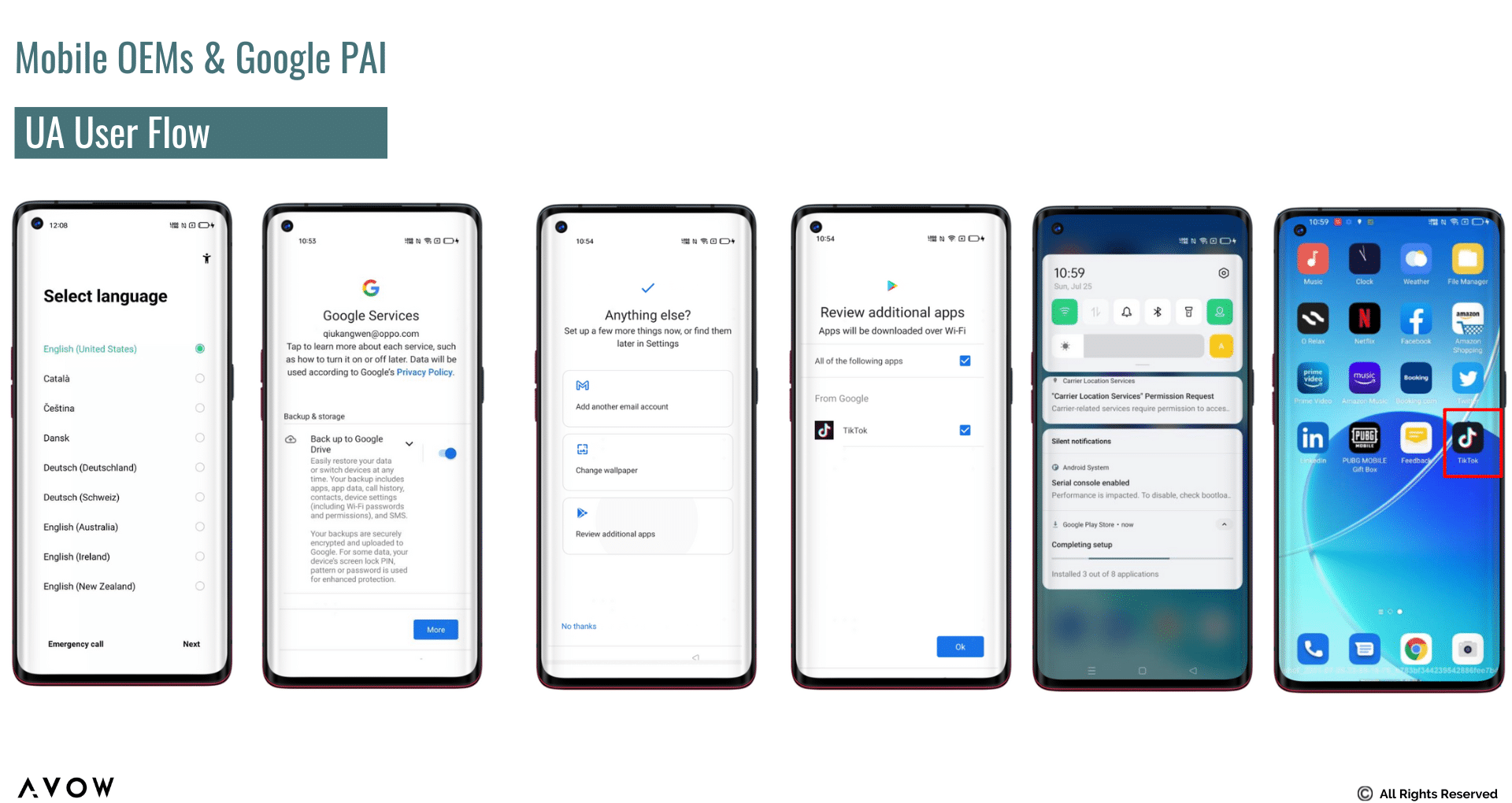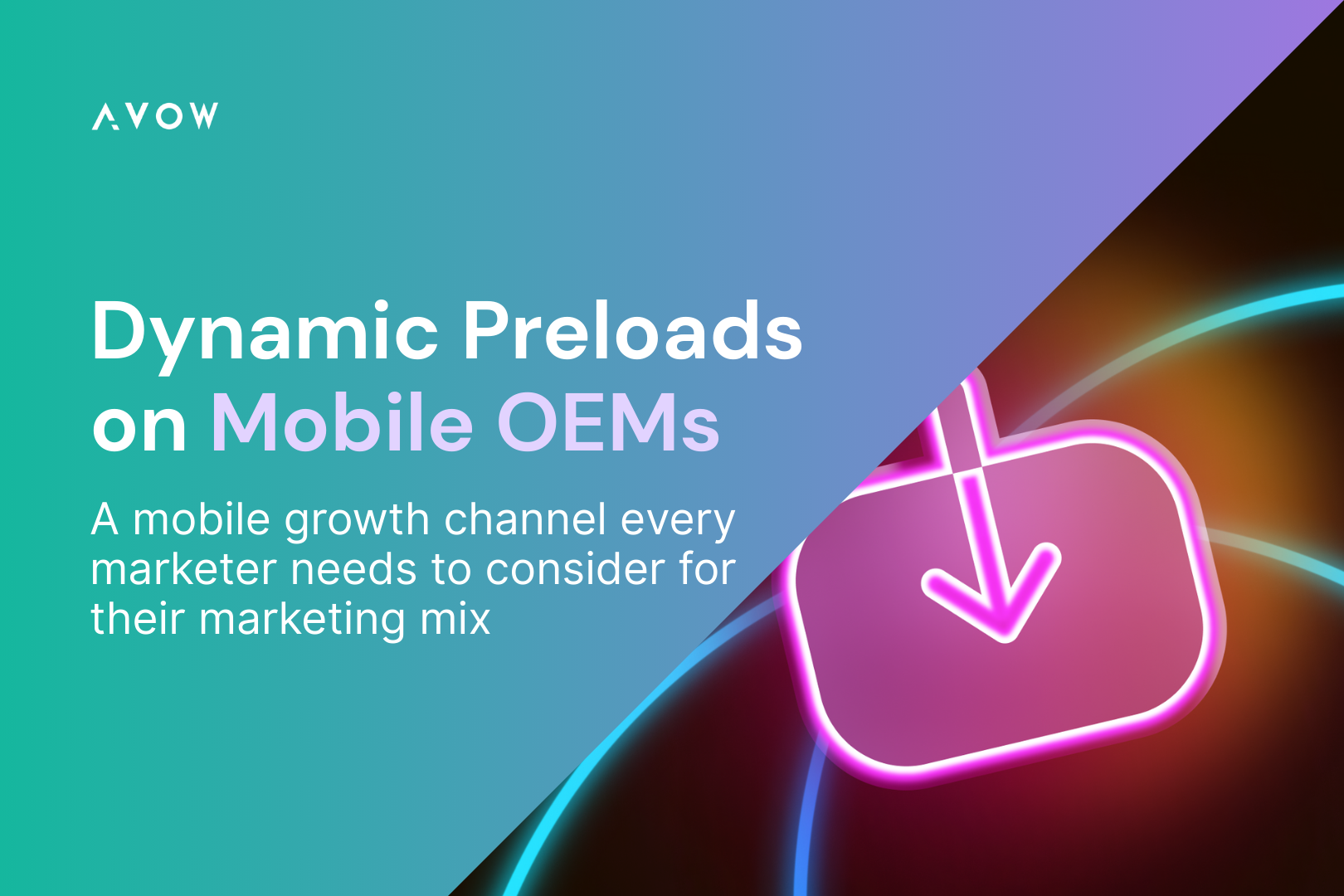
Before we explore the world of Dynamic Preloads, we recommend you read our comprehensive Dynamic Preloads Guide for valuable insights and strategies to maximize advantages for mobile marketers and app developers. Now, let’s delve into the essentials, starting with a quick overview of Mobile OEM advertising.
What are Mobile OEMs & Mobile OEM advertising?
Mobile OEMs, or original equipment manufacturers, are companies that design and produce mobile devices such as smartphones, tablets, and wearables. The mobile OEM market includes brands such as Xiaomi, OPPO, Vivo, and many more, all of whom have launched their own alternative app stores, which have their own store fronts, app promotion and app discovery solutions. Covering 70+% of the global android market share and providing access to over 1.5 billion daily active users, mobile OEMs offer a unique and scalable opportunity for app developers and mobile marketers as an alternative pathway to reach audiences that Google and Facebook cannot access.
Mobile OEMs in the Global Mobile Phone Market
In 2024, global smartphone shipments rebounded strongly, rising by 7.1% to approximately 1.223 billion units, marking the industry’s best annual growth since 2021. Today, 7 out of 10 smartphones globally run on Android, giving it a commanding market share, while iOS holds about 27%.
Within the Android ecosystem, leading Android OEMs like Samsung, Xiaomi, Huawei, OPPO, Vivo and others, not only dominate device sales but also operate their own app store ecosystems. These manufacturers offer app marketers powerful, scalable distribution alternatives through solutions like Dynamic Preloads and alternative app stores. These channels help developers reach users beyond the crowded Google Play and traditional ad networks.
What are Dynamic Preloads?
Basically – Dynamic Preloads are apps that are installed on brand new smartphones. Dynamic Preloads happen when the users activate the mobile device for the first time and are presented with the opportunity to download the app while the mobile setup occurs.
It’s a great and highly relevant way to amplify user acquisition strategy where mobile marketers can think of dynamic preloads as a premium way for user acquisition to stay ahead of their competition.
💡Pro tip: For a deeper look, read this in-depth Dynamic Preloads Guide.

How do Dynamic Preloads work – technically?
Mobile OEMs such as OPPO, Vivo, and Xiaomi can configure which apps will be recommended in the Google portal and which group of devices to reach and target. Google created an auto-install functionality – the Google Play AutoInstall (Google PAI) – within Mobile OEMs that automatically downloads apps from the Play Store.

With Dynamic Preloads, the mobile app download takes place directly from the Google Play Store, and it occurs over the air (OTA) where Android Application Packages (APKs) get automatically downloaded via the Play Store once the device is connected to a network. This is unlike any other preload offerings by companies where APKs are pushed for downloads and in the end, users might not get the latest version of the preloaded app even after doing multiple long-drawn-out processes.
Google uses an app bundle to generate and serve optimized APKs for each user’s device configuration, so they can download only the code and resources they need to run your app. AVOW makes it faster, more agile, and better reliable for the overall user growth strategy of your app with Google’s Play AutoInstall (PAI) feature which is more efficient and effective than APK preinstall configuration.
Example: Launching a Game App in India
India is one of the fastest-growing gaming markets. In 2024, mobile gaming revenues reached about US $3.1 billion, with the player base set to exceed 450 million by 2025. For developers, this scale brings both opportunity and competition – making mobile OEM partnerships a key pathway to reach users effectively.
Therefore, the mobile gaming category will continue to bear huge growth potential in this region in the coming years. As an Indian app developer or mobile marketer, one can gain the substantial competitive advantage one needs to launch a game app successfully – as Dynamic Preloads apps can create massive opportunities to gain new users each time a smartphone is activated by first-time users and elevate the app brand at the same time since the app is visible in a premium spot.
Dynamic Preloads vs. Traditional Preloads
As the mobile industry continues to innovate, app advertisers increasingly find themselves at a crossroads between using Dynamic Preloads or Traditional Preloads. The decision is not simply a case of one being better than the other, but rather what might be the best fit when taking into account one’s goals and budget.
Traditional Preloads can offer marketers a “guaranteed” volume of downloads, as the app would be pre installed in every phone that is shipped. This also increases the OEM inventory available to marketers and the inventory is not dependent on what competitors might be bidding for that inventory. Furthermore, many international markets are “dominated by carriers”. meaning, each dynamic preload campaign requires carrier consent to run. This obstacle is nullified when booking a factory preload deal. However, Traditional Preloads require a minimum yearly commitment, and does not have the flexibility in pricing that Dynamic Preloads offer. The beauty about a yearly commitment however lies in the negotiation power an advertiser has and the resulting lower Cost per Install (CPI).
Dynamic Preloads on the other hand operate solely on a Cost per Install (CPI) model, which forgoes “guaranteed” volume for a more curated approach, as users would still have to actively consent and choose to have the app on their phones. This also means that marketers have more flexibility with pricing and only pay for every installation of the app, thereby reducing their financial outlay and commitment from the outset. Dynamic Preloads however have a smaller OEM inventory, with available inventory subjected to how much a marketer bids. Running a dynamic preload campaign also does not require any additional technical work as there no separate APK or testing is required. The campaigns can be set up straight from the user acquisition team.
At its core, the choice between the two boils down to needs and goals, as well as the available budget. In short, one could look at it as a quantity vs quality approach, with both solutions offering their own sets of advantages for different needs. This is where having market experts with years of experience in the industry can make the difference in helping you make the right choice when choosing the best preloads solution.
Seven things every mobile marketer should know about Dynamic Preloads:
- Users get the latest version of the app pre-installed once they use the phone for the first time.
- It takes smaller budgets as compared to regular factory preload advertising budgets to acquire users.
- App developers can see a quicker turnaround from the launch to app discovery.
- No SDK implementation or technical integration is required for advertisers.
- The advertiser pays for a launch which is (Cost per install).
- Users get an ‘opt-out’ functionality if they wish not to use the app.
- Ability to optimize based on device models after the initial launch.
Dynamic Preloads are the way forward
If you’re looking to get your app in front of most of the customers of these smartphone OEMs, Dynamic Preloads offer one of the most effective, exclusive, and direct routes to do so most reliably. And since your app is available to users by being on the device first, it gives your app strong visibility to be a ‘go-to’ app for a fresh set of users.
AVOW’s territorial exclusivity and partnership with OEMs can help you reach closer to your user acquisition goals with Dynamic Preload options. AVOW can effectively help app developers, and brands launch their apps on dedicated phones with specific geo-targeting depending on the markets they want to reach.
Connect with our team today to learn how AVOW’s unique offering can help scale your business by implementing Dynamic Preloads for user acquisition.
For an immediate dive into detailed strategies, explore this comprehensive Dynamic Preloads and Mobile Gaming Guide.

About the Author






